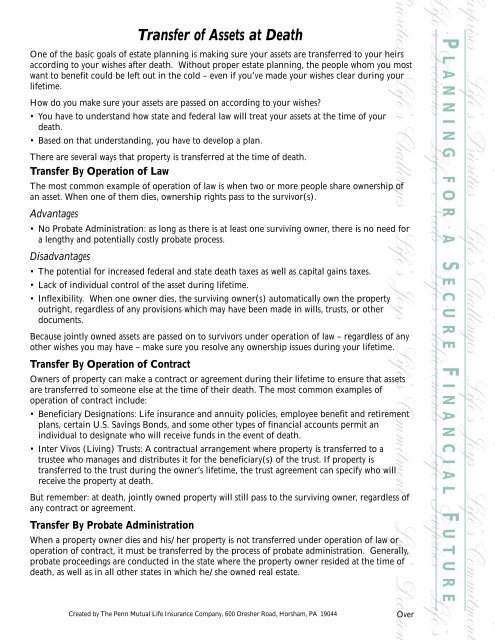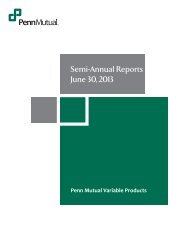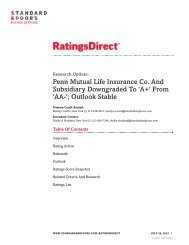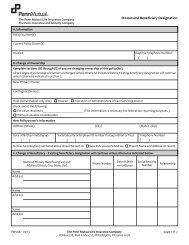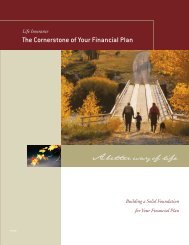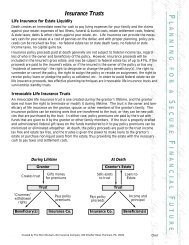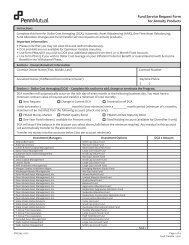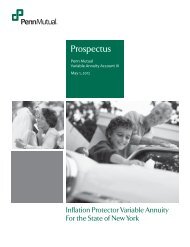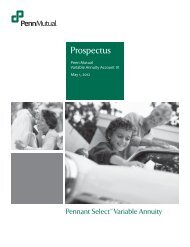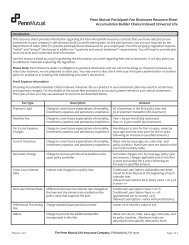Transfer of Assets at Death Handout - Penn Mutual Life
Transfer of Assets at Death Handout - Penn Mutual Life
Transfer of Assets at Death Handout - Penn Mutual Life
You also want an ePaper? Increase the reach of your titles
YUMPU automatically turns print PDFs into web optimized ePapers that Google loves.
<strong>Transfer</strong> <strong>of</strong> <strong>Assets</strong> <strong>at</strong> De<strong>at</strong>h<br />
One <strong>of</strong> the basic goals <strong>of</strong> est<strong>at</strong>e planning is making sure your assets are transferred to your heirs<br />
according to your wishes after de<strong>at</strong>h. Without proper est<strong>at</strong>e planning, the people whom you most<br />
want to benefit could be left out in the cold – even if you’ve made your wishes clear during your<br />
lifetime.<br />
How do you make sure your assets are passed on according to your wishes?<br />
• You have to understand how st<strong>at</strong>e and federal law will tre<strong>at</strong> your assets <strong>at</strong> the time <strong>of</strong> your<br />
de<strong>at</strong>h.<br />
• Based on th<strong>at</strong> understanding, you have to develop a plan.<br />
There are several ways th<strong>at</strong> property is transferred <strong>at</strong> the time <strong>of</strong> de<strong>at</strong>h.<br />
<strong>Transfer</strong> By Oper<strong>at</strong>ion <strong>of</strong> Law<br />
The most common example <strong>of</strong> oper<strong>at</strong>ion <strong>of</strong> law is when two or more people share ownership <strong>of</strong><br />
an asset. When one <strong>of</strong> them dies, ownership rights pass to the survivor(s).<br />
Advantages<br />
• No Prob<strong>at</strong>e Administr<strong>at</strong>ion: as long as there is <strong>at</strong> least one surviving owner, there is no need for<br />
a lengthy and potentially costly prob<strong>at</strong>e process.<br />
Disadvantages<br />
• The potential for increased federal and st<strong>at</strong>e de<strong>at</strong>h taxes as well as capital gains taxes.<br />
• Lack <strong>of</strong> individual control <strong>of</strong> the asset during lifetime.<br />
• Inflexibility. When one owner dies, the surviving owner(s) autom<strong>at</strong>ically own the property<br />
outright, regardless <strong>of</strong> any provisions which may have been made in wills, trusts, or other<br />
documents.<br />
Because jointly owned assets are passed on to survivors under oper<strong>at</strong>ion <strong>of</strong> law – regardless <strong>of</strong> any<br />
other wishes you may have – make sure you resolve any ownership issues during your lifetime.<br />
<strong>Transfer</strong> By Oper<strong>at</strong>ion <strong>of</strong> Contract<br />
Owners <strong>of</strong> property can make a contract or agreement during their lifetime to ensure th<strong>at</strong> assets<br />
are transferred to someone else <strong>at</strong> the time <strong>of</strong> their de<strong>at</strong>h. The most common examples <strong>of</strong><br />
oper<strong>at</strong>ion <strong>of</strong> contract include:<br />
• Beneficiary Design<strong>at</strong>ions: <strong>Life</strong> insurance and annuity policies, employee benefit and retirement<br />
plans, certain U.S. Savings Bonds, and some other types <strong>of</strong> financial accounts permit an<br />
individual to design<strong>at</strong>e who will receive funds in the event <strong>of</strong> de<strong>at</strong>h.<br />
• Inter Vivos (Living) Trusts: A contractual arrangement where property is transferred to a<br />
trustee who manages and distributes it for the beneficiary(s) <strong>of</strong> the trust. If property is<br />
transferred to the trust during the owner’s lifetime, the trust agreement can specify who will<br />
receive the property <strong>at</strong> de<strong>at</strong>h.<br />
But remember: <strong>at</strong> de<strong>at</strong>h, jointly owned property will still pass to the surviving owner, regardless <strong>of</strong><br />
any contract or agreement.<br />
<strong>Transfer</strong> By Prob<strong>at</strong>e Administr<strong>at</strong>ion<br />
When a property owner dies and his/her property is not transferred under oper<strong>at</strong>ion <strong>of</strong> law or<br />
oper<strong>at</strong>ion <strong>of</strong> contract, it must be transferred by the process <strong>of</strong> prob<strong>at</strong>e administr<strong>at</strong>ion. Generally,<br />
prob<strong>at</strong>e proceedings are conducted in the st<strong>at</strong>e where the property owner resided <strong>at</strong> the time <strong>of</strong><br />
de<strong>at</strong>h, as well as in all other st<strong>at</strong>es in which he/she owned real est<strong>at</strong>e.<br />
P LANNING FOR A S ECURE F INANCIAL F UTURE<br />
Cre<strong>at</strong>ed by The <strong>Penn</strong> <strong>Mutual</strong> <strong>Life</strong> Insurance Company, 600 Dresher Road, Horsham, PA 19044<br />
Over
Purposes <strong>of</strong> Prob<strong>at</strong>e Administr<strong>at</strong>ion<br />
• To prove th<strong>at</strong> a Will is authentic, valid, and effective under st<strong>at</strong>e law.<br />
• To assure th<strong>at</strong> all debts, expenses, and other liabilities are paid.<br />
• To transfer property to those entitled to it under the terms <strong>of</strong> a Will, or if there is no Will, to<br />
those entitled to it under st<strong>at</strong>e law.<br />
Advantages <strong>of</strong> Prob<strong>at</strong>e Administr<strong>at</strong>ion<br />
• Est<strong>at</strong>e administr<strong>at</strong>ion is handled by a court, ensuring th<strong>at</strong> any problems, disputes, or other<br />
m<strong>at</strong>ters th<strong>at</strong> might arise are resolved impartially.<br />
• Any rights th<strong>at</strong> creditors may have to est<strong>at</strong>e assets are termin<strong>at</strong>ed by prob<strong>at</strong>e proceedings,<br />
preventing them from asserting claims against the property <strong>at</strong> a l<strong>at</strong>er d<strong>at</strong>e.<br />
• Inherited property receives a "stepped up" cost basis for tax purposes so th<strong>at</strong> if it is l<strong>at</strong>er sold,<br />
capital gains taxes will be reduced or elimin<strong>at</strong>ed. Also, with a properly drafted Will, federal and<br />
st<strong>at</strong>e de<strong>at</strong>h taxes can be minimized.<br />
• An <strong>of</strong>ficial record documenting the ownership <strong>of</strong> property is cre<strong>at</strong>ed, elimin<strong>at</strong>ing the need to<br />
prove ownership in the future.<br />
Disadvantages <strong>of</strong> Prob<strong>at</strong>e Administr<strong>at</strong>ion<br />
• Prob<strong>at</strong>e administr<strong>at</strong>ion can be complic<strong>at</strong>ed, costly and confusing.<br />
• Legal fees, court costs, executor’s fees, and other expenses <strong>of</strong> est<strong>at</strong>e settlement may be<br />
substantial.<br />
• The final distribution <strong>of</strong> est<strong>at</strong>e assets can be delayed for months or even years.<br />
• Dealing with money and family issues in this way can be very stressful.<br />
• Prob<strong>at</strong>e is generally a m<strong>at</strong>ter <strong>of</strong> public record resulting in a lack <strong>of</strong> privacy. Others may have<br />
access to your personal and financial m<strong>at</strong>ters.<br />
Each <strong>of</strong> the above methods <strong>of</strong> transferring property <strong>at</strong> de<strong>at</strong>h has its advantages and disadvantages. But remember,<br />
the various methods are mutually exclusive - if property is transferred under one method, then the other<br />
methods do not oper<strong>at</strong>e. For example, property th<strong>at</strong> is jointly owned will autom<strong>at</strong>ically pass to the surviving<br />
owner(s) regardless <strong>of</strong> any provisions in a will or trust agreement. Similarly, the design<strong>at</strong>ed beneficiary <strong>of</strong> a life<br />
insurance policy will receive the proceeds when the insured dies, regardless <strong>of</strong> the terms <strong>of</strong> the insured’s will.<br />
Th<strong>at</strong>’s why it is extremely important to examine the ownership <strong>of</strong> assets, beneficiary design<strong>at</strong>ions, and the terms<br />
<strong>of</strong> any Wills or Trusts Agreements, to assure th<strong>at</strong> all elements <strong>of</strong> an est<strong>at</strong>e plan are properly coordin<strong>at</strong>ed with<br />
one another and th<strong>at</strong> property and assets will be transferred <strong>at</strong> de<strong>at</strong>h as intended.<br />
Will<br />
Property<br />
<strong>Transfer</strong>red<br />
Based on<br />
Terms <strong>of</strong> Will<br />
Prob<strong>at</strong>e <strong>Assets</strong><br />
No Will<br />
Property<br />
<strong>Transfer</strong>red<br />
Under St<strong>at</strong>e<br />
Intestacy Law<br />
<strong>Transfer</strong> <strong>at</strong> De<strong>at</strong>h<br />
Non-Prob<strong>at</strong>e <strong>Assets</strong><br />
Contract<br />
<strong>Assets</strong><br />
Property<br />
<strong>Transfer</strong>red<br />
to Design<strong>at</strong>ed<br />
Beneficiary(s)<br />
Joint<br />
Ownership<br />
Property<br />
<strong>Transfer</strong>red<br />
to Surviving<br />
Owner(s)<br />
P LANNING FOR A S ECURE F INANCIAL F UTURE


